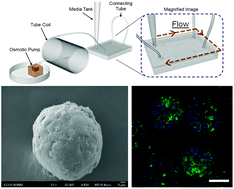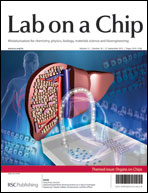Spheroid-based three-dimensional liver-on-a-chip to investigate hepatocyte–hepatic stellate cell interactions and flow effects†
Abstract
We have developed a three-dimensional (3D) liver-on-a-chip to investigate the interaction of hepatocytes and hepatic stellate cells (HSCs) in which primary 3D hepatocyte spheroids and HSCs are co-cultured without direct cell–cell contact. Here, we show that the 3D liver chip offers substantial advantages for the formation and harvesting of spheroids. The most important feature of this liver chip is that it enables continuous flow of medium to the cells through osmotic pumping, and thus requires only minimal handling and no external power source. We also demonstrate that flow assists the formation and long-term maintenance of spheroids. Additionally, we quantitatively and qualitatively investigated the paracrine effects of HSCs, demonstrating that HSCs assist in the maintenance of hepatocyte spheroids and play an important role in the formation of tight cell–cell contacts, thereby improving liver-specific function. Spheroids derived from co-cultures exhibited improved albumin and urea secretion rates compared to mono-cultured spheroids after 9 days. Immunostaining for

- This article is part of the themed collection: Organs on a Chip 2013

 Please wait while we load your content...
Please wait while we load your content...